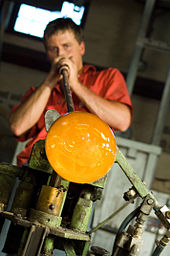Glassmaker

Glassmaker is the job title for skilled glass workers. They make all kinds of glasses . Depending on the product, the glasses are either hand-blown, made by hand or with the help of automatic machines. Although the glassmaker also blows glass, the job description of the glassblower is limited to the formation of glass “in front of the lamp”, i.e. the open burner.
The majority of glassmakers work in the glass industry , for example with hollow glass manufacturers, in glassworks (there mostly in studio departments) or in special glassworks with antique glass production.
description
Glassmakers remove lumps of glass from the harbor or tank furnace using a glassmaker's pipe or a glassmaker's iron, a long pipe or steel rod. These are processed into the desired semi-finished or finished products by turning, blowing and targeted cooling using wood, metal or paper tools. The glassmaker usually differentiates between different tools made of metal or wood, now also graphite. Metal tools are, for example, circular shears, lump shears or simple scissors, which are used for production due to their different shape and handling. Wooden tools can be so-called boards, bulging woods and, for example, grooves and of course shapes for blowing in. Because of the specific demands on the wood, pear is preferred. In preparation, the contact surface is charred with a gas burner or hot glass and then soaked in water just as between uses. The charcoal layer created by the charring becomes full of water. If the hot workpiece comes into contact with the mold, the water evaporates. The liquid glass then slides on the surface of the steam as it rotates during processing, creating an absolutely smooth surface.
In general, the tools that are still used today have a very strong regional character and are often used with different terms. As with other craft trades, each glassmaker uses his own tools that he does not lend. Glassmakers work in traditional Bavarian or Bohemian craft in groups of two to five people. Each craftsman only carries out part of the manufacturing process and then passes the workpiece on to another glassmaker. One of the most difficult jobs for a glassmaker is making the stem and base of a drinking glass. This activity is therefore also carried out by the masters. The actual blowing of a so-called glass bulb or a glass ball is usually a less strenuous activity that usually requires little lung strength. The glassmaker's activity and his tools have changed only slightly over the past 1000 years. Glassmakers from the Mediterranean, such as those in Italy or Spain, use different techniques than northern or central European glassmakers.
history
Historically, glassmaker was the collective term (the generic term) for various specialists involved in production. Before the era of industrial glass production, i.e. before the 19th century, glass was produced in traveling glass works. Every 10–20 years at the latest, a wood coal-fired glassworks had to change its location because the forest trees needed to fire the furnace and the beech trees needed to reduce the melting range had been cleared over a wide area. The huts were run by a private entrepreneur. This master glass master obtained permission from the landlord to operate the temporary smelter at one location, employed the workers, kept the manufacturing processes as trade secrets and marketed the production. The ironworks consisted of 40–60 people who were mostly closely related and related by marriage and married with one another, that is, they looked for their partners in other glassmaking clans. The hut included lumberjacks, shearers, shepherds, weavers, beginners (Kaier), Kölbel makers, blowers, masters and one-porters.
A special feature of the contracts with the landlords and owners of the glassworks was the unlimited use of beer as a drink, as the loss of fluids and minerals is particularly high due to the high temperatures and the strenuous activity. A glassmaker consumes more energy in normal work than a steel worker.
In Germany, from the industrial revolution to German reunification, there were a particularly large number of glassworks in Lusatia , which had particularly good conditions due to their rich coal, forest and sand deposits and thus attracted and trained many glass makers. As a result , there was a particularly high density of glassworks in Weißwasser , eleven in number. In Europe, the island of Murano near Venice is still known for its long tradition of glass processing on the kiln.
education
The apprenticeship as a glassmaker takes three years in Germany and is offered in the industry. The vocational school lessons usually take place as block lessons in specialist classes.
See also
literature
- Walter Greiner: On the trail of the glassmaker. From modern times to biblical times. Self-published, Sonthofen 2005, ISBN 3-00-017027-8 .


